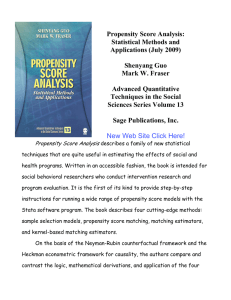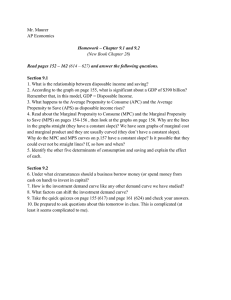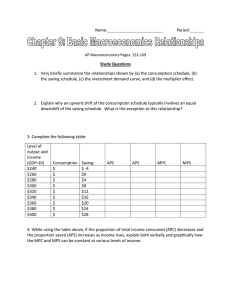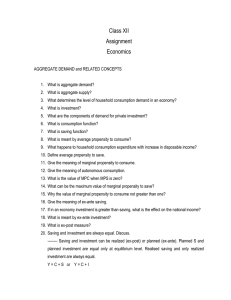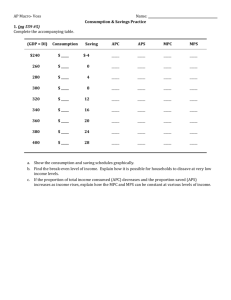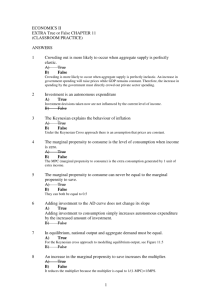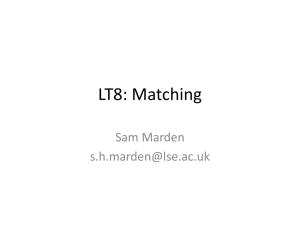THE UNIVERSITY OF NORTH CAROLINA AT CHAPEL HILL COURSE NUMBER:
advertisement
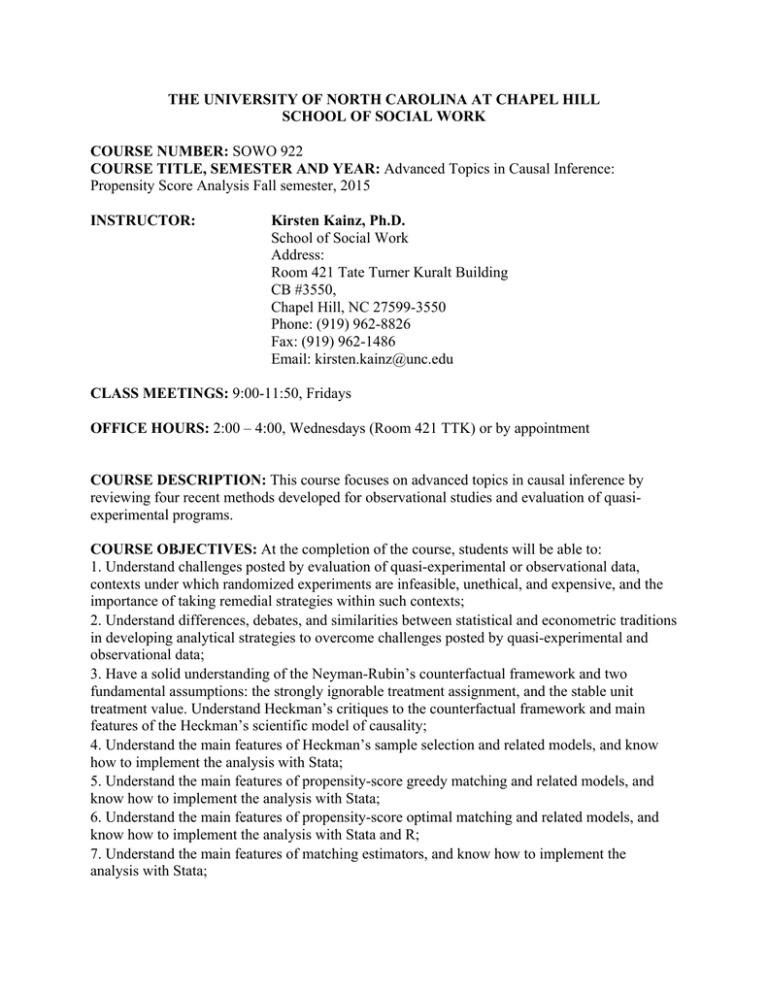
THE UNIVERSITY OF NORTH CAROLINA AT CHAPEL HILL SCHOOL OF SOCIAL WORK COURSE NUMBER: SOWO 922 COURSE TITLE, SEMESTER AND YEAR: Advanced Topics in Causal Inference: Propensity Score Analysis Fall semester, 2015 INSTRUCTOR: Kirsten Kainz, Ph.D. School of Social Work Address: Room 421 Tate Turner Kuralt Building CB #3550, Chapel Hill, NC 27599-3550 Phone: (919) 962-8826 Fax: (919) 962-1486 Email: kirsten.kainz@unc.edu CLASS MEETINGS: 9:00-11:50, Fridays OFFICE HOURS: 2:00 – 4:00, Wednesdays (Room 421 TTK) or by appointment COURSE DESCRIPTION: This course focuses on advanced topics in causal inference by reviewing four recent methods developed for observational studies and evaluation of quasiexperimental programs. COURSE OBJECTIVES: At the completion of the course, students will be able to: 1. Understand challenges posted by evaluation of quasi-experimental or observational data, contexts under which randomized experiments are infeasible, unethical, and expensive, and the importance of taking remedial strategies within such contexts; 2. Understand differences, debates, and similarities between statistical and econometric traditions in developing analytical strategies to overcome challenges posted by quasi-experimental and observational data; 3. Have a solid understanding of the Neyman-Rubin’s counterfactual framework and two fundamental assumptions: the strongly ignorable treatment assignment, and the stable unit treatment value. Understand Heckman’s critiques to the counterfactual framework and main features of the Heckman’s scientific model of causality; 4. Understand the main features of Heckman’s sample selection and related models, and know how to implement the analysis with Stata; 5. Understand the main features of propensity-score greedy matching and related models, and know how to implement the analysis with Stata; 6. Understand the main features of propensity-score optimal matching and related models, and know how to implement the analysis with Stata and R; 7. Understand the main features of matching estimators, and know how to implement the analysis with Stata; 8. Understand the main features of kernel-based matching and related models, and know how to implement the analysis with Stata; 9. Understand the main features of Rosenbaum’s sensitivity analysis to evaluate potential bias due to hidden selection, and know how to implement the analysis with Stata; 10. Know how to read, evaluate, and criticize evaluation studies. PRE-REQUIREMENT: Students are assumed to be familiar with descriptive and inferential statistics. They should have statistical and statistical software background at least equivalent to that provided by SOWO 919 “Applied Regression Analysis and Generalized Linear Models”. Students without such prerequisites should contact the instructor to determine their eligibility to take the course. STATISTICAL SOFTWARE PACKAGE: This course will use Stata, R, and SAS. Example code will be provided. REQUIRED TEXTS/READINGS: Guo, S. & Fraser, W.M. (2015). Propensity Score Analysis: Statistical Methods and Applications, 2nd Edition. Thousand Oaks, CA: Sage Publications. All required journal articles are available on the course Sakai site. POLICIES Grading System The standard of School of Social Work’s interpretation of grades and numerical scores will be used. H = 94-100 P = 80-93 L = 70-79 F = 69 and below HWK 1 HWK 2 HWK 3 HWK 4 Mid-Term Presentation Mid-Term Paper Final Presentation Final Paper TOTAL 5 pts. 5 pts. 5 pts. 5 pts. 5 pts. 30 pts. 5 pts. 40 pts. 100 pts. Policy on Attendance Class attendance will be essential for content and skill learning, and you are expected to attend all scheduled sessions. It’s a student’s responsibility to inform the instructor via email in advance for missing a class session. You are expected not to miss more than two sessions for the whole semester. Policy on Late and Incomplete Assignments Assignments are to be turned in to the professor by the due date noted in the course outline. In most cases, late assignments will not be accepted. In the case of an emergency extensions may be granted by the professor, but students should contact the professor before the due date to determine if their case is an emergency. Late assignments will be reduced 10 percent for each day late (including weekend days). A grade of incomplete will be given only under extenuating circumstances and in accordance with University policy. COURSE FORMAT, OUTLINE, AND ASSIGNMENTS Format The course format will include a mixture of lecture, discussion/presentation, and practical work with data. The goal of the mixed formatting is to ensure that students build conceptual knowledge about causal inference and selection bias in observational studies, practical skill addressing data analytic challenges, and expertise participating in authentic discussions and creating scholarly products related to the course topics. By the end of the course students should be able to: 1) understand, speak about, and write about major ideas from counterfactual and potential outcomes frameworks that motivate quasi-experimental methods such as propensity score analysis; 2) critically evaluate research that uses propensity score analysis so as to provide expert peer reviews and research syntheses for journals; 3) conduct defensible propensity score analyses using recommended practices; and 4) understand the limitations of propensity score analysis and consider alternative quasiexperimental methods. Outline Date Aug 21 Aug 28 Topic Introduction: The context for evidence-based policy Counterfactual framework and observational studies Discussion Activity Sep 4 Statistical and Econometric Perspectives HWK 1 Presentations Sep 11 Introduction to Propensity Scores Discussion Activity Readings Chapter 2 Guo & Fraser 2137, 62-65 Rubin, 2007 Rubin, 2008 (Section 3 only) Chapter 3 Guo & Fraser Chapter 4 Guo & Fraser 95100, 127-28 Chapter 5 Guo & Fraser PT: *Austin, 2011 *Shadish, 2013 *Shadish & Steiner, 2010 Sep 18 Propensity Scores and Matching: STATA psmatch2– Meet in Lab 227 *Stuart & Rubin, 2008 *Thoemmes &Kim, 2011 Sep 25 Propensity Scores and Matching: STATA teffects psmatch– Meet in Lab 227 HWK 2 Due Propensity Scores and Matching: R Matchit Meet in Lab 227 *Stuart, 2010 Oct 2 Oct 9 Oct 16 Oct 23 Oct 30 Nov 6 Nov 13 *Stuart & Green, 2008 *Ho et al., 2007 Student Mid-Term Presentations Mid-Term Paper Due by Noon FALL BREAK Propensity Scores: sub-classification, weighting, and regression adjustment - Meet in Lab 227 HWK 3 Due Propensity Scores and Matching: Missing data and clustered data HWK 4 Due Interrupted Time Series Discussion Activity Regression Discontinuity Discussion Activity Nov 20 Nov 30 *Reading is available on Sakai Chapters 6, 7 Guo & Fraser *Harder, Stuart &Anthony *Hong & Yu, 2008 *Green & Stuart, 2014 *Wong, Cook, & Steiner, 2015 *Shadish, 2010 *Berk et al., 2010 *Imbems & Lemieux, 2008 Student Final Presentations Final Paper Due by Noon Assignments Final and Mid-Term Papers For the final assignment students will produce a systematic literature review of published, peerreviewed research entitled “Propensity Score Analysis in [insert your topic] Research: The State of the Field”, and the Mid Term Assignment will serve as a product that gets students part-way to the final paper. Research topics can be as broad as School Social Work, or as bounded as Hospitalization and Subsequent Health Outcomes among Burmese Immigrants in the Southeastern United States: 2010-2014, depending on a student’s interests and the amount of published research using propensity scores available to review. Ideally, the systematic review should cover all peer-reviewed propensity score analyses in the topic area, and, at a minimum, the review should cover no fewer than 10 studies. For the mid-term assignment, students will submit responses to items #1, #2, #3 below. For the final assignment, students will build on their mid-term assignment (updating as needed) and respond to items #4, and #5 below. In a successful review, students will: 1) In no more than three pages introduce the research topic and describe propensity score methods and the problem propensity score methods aim to solve within the research topic; 2) Thoroughly describe the method for retrieving published research using propensity scores and selecting studies for review. Report the studies to be reviewed in a table with these column headings: citation; sample size; ’treatment’; outcome; software used; method to create exchangeable groups (i.e., matching, stratification, weighting, other) 3) Thoroughly describe the criteria to be used to evaluate the quality of propensity score analyses in the research topic. These criteria must include but are not limited to evaluation of: (a) the completeness of reporting (do the authors tell you what you need to know to judge the quality of methods and ultimately the inferences made?); (b) the description of the selection mechanism for ‘treatment’; (c) the software, method, and model used to estimate propensity scores and create exchangeable groups; (d) the analysis of ‘treatment’ effects following propensity score estimation; and (e) the ultimate defensibility of the inferences drawn from the analyses; 4) Using the criteria outlined in item #3, evaluate the strengths and weaknesses of published research selected for review; and, 5) Summarize your review findings and make recommendations for how to improve the quality of inferences in your topic area with rigorous and defensible propensity score analysis. Final and Mid-Term Presentations For the mid-term presentation students will present an update on their research topic and the types/number of published studies using propensity score analysis in their research area. The mid-term presentation should answer these questions: • • • • • • What’s the research topic – what’s the ‘treatment’? Why is it important? How many studies with propensity score analyses are available for review? Are the studies clustered within particular journals in the field, or spread around? Are the studies conducted by certain kinds of researchers in the field, or spread around? What software and methods for creating exchangeable groups are used? For the final presentation students will present the results from their systematic review, making summary statements about the state of the field. The presentation should answer these questions: • • • • What’s the research topic – what’s the ‘treatment’? How many studies with propensity score analysis were reviewed? What criteria were used to evaluate studies? What are the major summary points from the evaluation? Homework Assignments Homework assignments can be found on Sakai ADDITIONAL RESOURCES Disability Services Information The University of North Carolina – Chapel Hill facilitates the implementation of reasonable accommodations, including resources and services, for students with disabilities, chronic medical conditions, a temporary disability or pregnancy complications resulting in difficulties with accessing learning opportunities. All accommodations are coordinated through the Accessibility Resources and Service Office. In the first instance please visit their website http://accessibility.unc.edu, call 919-962-8300 or email accessibility@unc.edu. Please contact ARS as early in the semester as possible. Honor Code The University of North Carolina at Chapel Hill has had a student-administered honor system and judicial system for over 100 years. The system is the responsibility of students and is regulated and governed by them, but faculty share the responsibility. If you have questions about your responsibility under the honor code, please bring them to your instructor or consult with the office of the Dean of Students or the Instrument of Student Judicial Governance. This document, adopted by the Chancellor, the Faculty Council, and the Student Congress, contains all policies and procedures pertaining to the student honor system. Your full participation and observance of the honor code is expected. If you require further information on the definition of plagiarism, authorized vs. unauthorized collaboration, unauthorized materials, consequences of violations, or additional information on the Honor Code at UNC, please visit http://honor.unc.edu. Policy on Prohibited Harassment and Discrimination The University’s Policy on Prohibited Harassment and Discrimination (http://www.unc.edu/campus/policies/harassanddiscrim.pdf) prohibits discrimination or harassment on the basis of an individual’s race, color, gender, national original, age, religion, creed, disability, veteran’s status, sexual orientation, gender identity or gender expression. Appendix B of this Policy provides specific information for students who believe that they have been discriminated against or harassed on the basis of one or more of these protected classifications. Students who want additional information regarding the University’s process for investigating allegations of discrimination or harassment should contact the Equal Opportunity /ADA Office for assistance at 919.966.3576 or via email at equalopportunity@unc.edu or through U.S. Mail at Equal Opportunity/ADA Office The University of North Carolina at Chapel Hill 100 East Franklin Street, Unit 110 Campus Box 9160 Campus Box 9160 Chapel Hill, NC 27599 References Austin, P. C. (2011). An introduction to propensity score methods for reducing the effects of confounding in observational studies. Multivariate behavioral research, 46(3), 399-424. Berk, R., Barnes, G., Ahlman, L., & Kurtz, E. (2010). When second best is good enough: a comparison between a true experiment and a regression discontinuity quasi-experiment. Journal of Experimental Criminology, 6(2), 191-208. Green, K. M., & Stuart, E. A. (2014). Examining moderation analyses in propensity score methods: Application to depression and substance use. Journal of consulting and clinical psychology, 82(5), 773. Harder, V. S., Stuart, E. A., & Anthony, J. C. (2010). Propensity score techniques and the assessment of measured covariate balance to test causal associations in psychological research. Psychological methods, 15(3), 234. Ho, D. E., Imai, K., King, G., & Stuart, E. A. (2007). Matching as nonparametric preprocessing for reducing model dependence in parametric causal inference. Political analysis, 15(3), 199-236. Hong, G., & Yu, B. (2008). Effects of kindergarten retention on children's social-emotional development: an application of propensity score method to multivariate, multilevel data. Developmental Psychology, 44(2), 407. Imbens, G. W., & Lemieux, T. (2008). Regression discontinuity designs: A guide to practice. Journal of econometrics, 142(2), 615-635. Rubin, D. B. (2007). The design versus the analysis of observational studies for causal effects: parallels with the design of randomized trials. Statistics in medicine, 26(1), 20-36. Rubin, D. B. (2008). For objective causal inference, design trumps analysis. The Annals of Applied Statistics, 808-840. Shadish, W. R. (2010). Campbell and Rubin: A primer and comparison of their approaches to causal inference in field settings. Psychological methods, 15(1), 3. Shadish, W. R. (2013). Propensity score analysis: promise, reality and irrational exuberance. Journal of Experimental Criminology, 9(2), 129-144. Shadish, W. R., & Steiner, P. M. (2010). A primer on propensity score analysis. Newborn and Infant Nursing Reviews, 10(1), 19-26. Stuart, E. A. (2010). Matching methods for causal inference: A review and a look forward. Statistical Science: a Review Journal of the Institute of Mathematical Statistics, 25(1), 1. Stuart, E. A., & Green, K. M. (2008). Using full matching to estimate causal effects in nonexperimental studies: examining the relationship between adolescent marijuana use and adult outcomes. Developmental psychology, 44(2), 395. Stuart, E. A., & Rubin, D. B. (2008). Best practices in quasi-experimental designs. Best practices in Quantitative Methods, 155-176. Wong, M., Cook, T. D., & Steiner, P. M. (2015). Adding design elements to improve interrupted time series designs: No Child Left Behind as an example of causal pattern-matching. Journal of Research on Educational Effectiveness, 8, 245-279.
